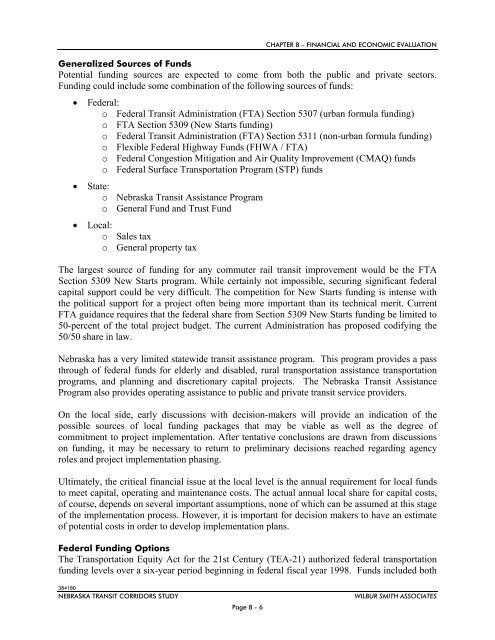NTRAC Final Study - Nebraska Department of Roads - State of ...
NTRAC Final Study - Nebraska Department of Roads - State of ...
NTRAC Final Study - Nebraska Department of Roads - State of ...
You also want an ePaper? Increase the reach of your titles
YUMPU automatically turns print PDFs into web optimized ePapers that Google loves.
CHAPTER 8 – FINANCIAL AND ECONOMIC EVALUATION<br />
Generalized Sources <strong>of</strong> Funds<br />
Potential funding sources are expected to come from both the public and private sectors.<br />
Funding could include some combination <strong>of</strong> the following sources <strong>of</strong> funds:<br />
Federal:<br />
o Federal Transit Administration (FTA) Section 5307 (urban formula funding)<br />
o FTA Section 5309 (New Starts funding)<br />
o Federal Transit Administration (FTA) Section 5311 (non-urban formula funding)<br />
o Flexible Federal Highway Funds (FHWA / FTA)<br />
o Federal Congestion Mitigation and Air Quality Improvement (CMAQ) funds<br />
o Federal Surface Transportation Program (STP) funds<br />
<strong>State</strong>:<br />
o <strong>Nebraska</strong> Transit Assistance Program<br />
o General Fund and Trust Fund<br />
Local:<br />
o Sales tax<br />
o General property tax<br />
The largest source <strong>of</strong> funding for any commuter rail transit improvement would be the FTA<br />
Section 5309 New Starts program. While certainly not impossible, securing significant federal<br />
capital support could be very difficult. The competition for New Starts funding is intense with<br />
the political support for a project <strong>of</strong>ten being more important than its technical merit. Current<br />
FTA guidance requires that the federal share from Section 5309 New Starts funding be limited to<br />
50-percent <strong>of</strong> the total project budget. The current Administration has proposed codifying the<br />
50/50 share in law.<br />
<strong>Nebraska</strong> has a very limited statewide transit assistance program. This program provides a pass<br />
through <strong>of</strong> federal funds for elderly and disabled, rural transportation assistance transportation<br />
programs, and planning and discretionary capital projects. The <strong>Nebraska</strong> Transit Assistance<br />
Program also provides operating assistance to public and private transit service providers.<br />
On the local side, early discussions with decision-makers will provide an indication <strong>of</strong> the<br />
possible sources <strong>of</strong> local funding packages that may be viable as well as the degree <strong>of</strong><br />
commitment to project implementation. After tentative conclusions are drawn from discussions<br />
on funding, it may be necessary to return to preliminary decisions reached regarding agency<br />
roles and project implementation phasing.<br />
Ultimately, the critical financial issue at the local level is the annual requirement for local funds<br />
to meet capital, operating and maintenance costs. The actual annual local share for capital costs,<br />
<strong>of</strong> course, depends on several important assumptions, none <strong>of</strong> which can be assumed at this stage<br />
<strong>of</strong> the implementation process. However, it is important for decision makers to have an estimate<br />
<strong>of</strong> potential costs in order to develop implementation plans.<br />
Federal Funding Options<br />
The Transportation Equity Act for the 21st Century (TEA-21) authorized federal transportation<br />
funding levels over a six-year period beginning in federal fiscal year 1998. Funds included both<br />
384180<br />
NEBRASKA TRANSIT CORRIDORS STUDY<br />
Page 8 - 6<br />
WILBUR SMITH ASSOCIATES

















